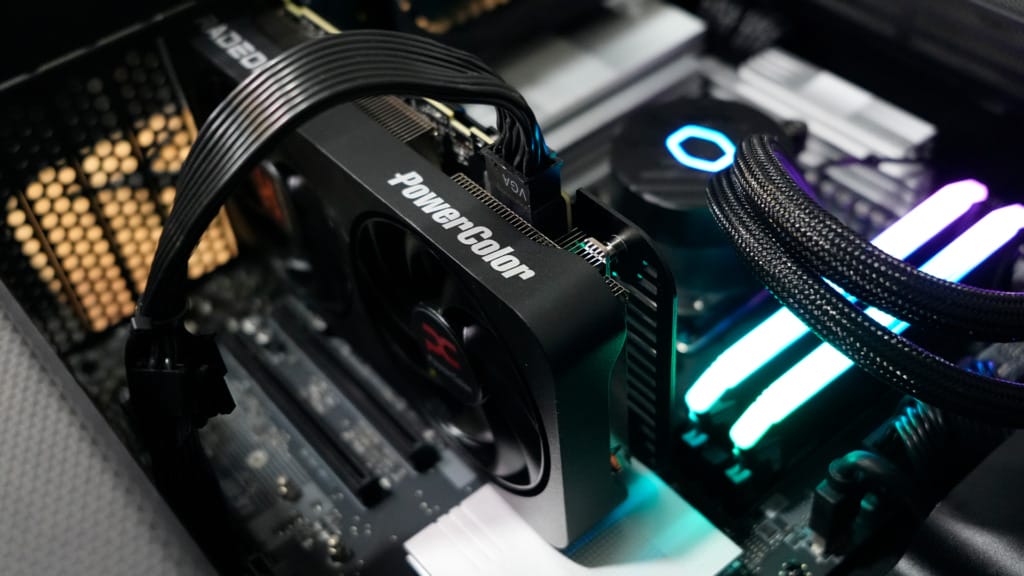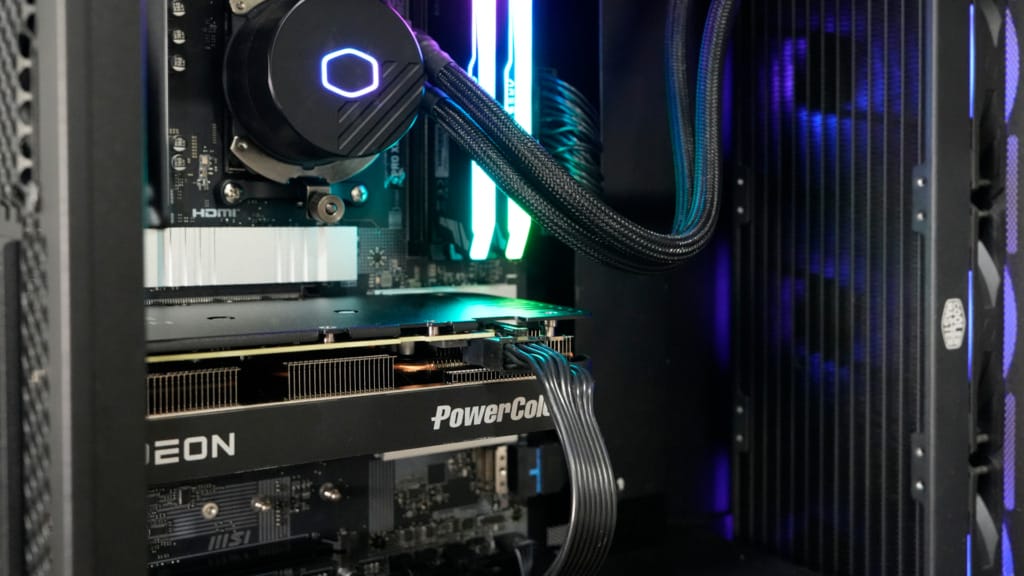AMD’s Radeon RX 9060 XT 16GB arrives at a critical moment in the graphics card landscape. With growing demand for high-performance gaming, AI-accelerated visuals, and generative content tools, the RX 9060 XT seeks to deliver both capability and value. Officially unveiled at COMPUTEX 2025 alongside the Ryzen Threadripper 9000 Series and Radeon AI PRO R9700, this card embodies AMD’s RDNA 4 vision—a blend of performance, efficiency, and scalability.
Built on TSMC’s 4nm process, the RX 9060 XT 16GB introduces a new tier of accessible power for gaming. With 32 compute units, 16GB of GDDR6 memory, and second-generation AI accelerators, it significantly surpasses the capabilities of the previous RX 7600. But the real story unfolds when this card is installed in a high-end system with a Ryzen 9 9950X processor and 32GB of RAM. Paired with this CPU’s 16-core muscle and ample memory bandwidth, the RX 9060 XT becomes more than a mid-tier GPU—it becomes a viable tool for serious play and productive workloads alike.
In an environment increasingly shaped by AI-enhanced rendering and high-resolution assets, the RX 9060 XT 16GB positions itself as a well-rounded, future-facing solution.
Gaming performance with RX 9060 XT

AMD built the RX 9060 XT to unlock fluid gaming at 1440p, and in this configuration, it delivers. Games such as F1 24, Call of Duty: Black Ops 6, and Assassin’s Creed Mirage consistently exceed 100 FPS at 1080p, and stay comfortably above 60 FPS at 1440p with high or ultra settings. The 16GB of VRAM proves particularly valuable in demanding titles with large textures or high draw distances, where 8GB cards often struggle.
On a Ryzen 9 9950X platform with 32GB of RAM, the RX 9060 XT runs unimpeded by CPU limitations. Its 3130 MHz boost clock is reached consistently, thanks to both architectural efficiency and excellent system cooling. In titles such as Horizon Zero Dawn Remastered and Resident Evil 4, gameplay remains responsive, even during extended sessions with maximum settings.
The RX 9060 XT also sees gains in productivity-focused game engines and simulators. In Total War: Warhammer III, for example, turn transitions and battlefield rendering are noticeably quicker when the GPU is backed by ample system memory and a fast CPU. This synergy is significant for players who require smooth performance in large-scale strategy games, content creation scenarios, or heavily modded environments.

Across genres, the RX 9060 XT 16GB demonstrates its ability to scale well in premium setups. Whether pushing esports frame rates at high refresh rates or handling cinematic single-player experiences with ray tracing, the card strikes a smart balance between consistency and headroom.
AI upscaling and machine learning integration
AMD’s integration of second-generation AI accelerators in the RX 9060 XT reflects a broader shift toward AI-assisted gaming and creative workloads. With 64 AI accelerators onboard, the card supports FidelityFX Super Resolution 4 (FSR 4), Fluid Motion Frames, and HYPR-RX, all of which utilise machine learning and adaptive upscaling to enhance performance without compromising image quality.
In games that support FSR 4, the RX 9060 XT shows tangible gains in both frame rates and visual clarity. Cyberpunk 2077 and Dragon Age: The Veilguard, for example, benefit from higher image fidelity at lower rendering costs, allowing the card to maintain excellent performance. While it lacks DLSS Frame Generation found on NVIDIA cards, the RX 9060 XT closes much of that gap through efficient upscaling and high raw compute throughput.
These AI features are not just cosmetic. When using AI-based visual enhancements and noise suppression tools built into the AMD Software Adrenalin Edition, there is no perceptible performance hit, even with background applications running. Features like Smart Access Video also allow for more efficient handling of video workloads on systems using Ryzen CPUs.
As generative tools and AI-driven game mechanics become more prevalent, the RX 9060 XT’s support for FP8 data types and structured sparsity positions it well for future content experiences.
Power draw, cooling and system behaviour
Efficiency is a standout quality of the RX 9060 XT 16GB. With a total board power of 160W, it draws less power than its nearest NVIDIA competitor, the RTX 5060 Ti (180W), and substantially less than Intel’s Arc B580 (190W). On a system powered by a 750W PSU, the GPU maintained consistent behaviour under load with no signs of instability or thermal throttling.

AMD’s implementation of the RX 9060 XT, paired with the Ryzen 9 9950X, showed decent thermal readings during stress tests. Even during gameplay lasting several hours, the card remained cool and quiet. Fan speeds were kept moderate.
This level of efficiency is especially relevant for users building systems in Singapore or other warm-climate regions, where ambient temperatures place additional stress on thermals. It also benefits compact builds and workstations where airflow might be limited. The RX 9060 XT delivers solid performance relative to its 160W power draw, reflecting the efficiency improvements of AMD’s RDNA 4 architecture.
Productivity, AI workloads and platform alignment
Beyond gaming, the RX 9060 XT performs reliably in productivity and media scenarios. Its 16GB of VRAM allows it to handle GPU-accelerated tasks in Adobe Premiere Pro, DaVinci Resolve, and Blender without excessive caching to system RAM. Timeline scrubbing is responsive, and exports using AV1 encoding are completed faster than on previous-generation AMD GPUs.
AV1 support also enhances streaming workflows, with reduced bandwidth consumption and improved compression. The RX 9060 XT’s hardware-based encoders enable it to maintain high video quality at lower bitrates, making it particularly useful for livestreaming or capturing gameplay for later editing.
On the AI side, the RX 9060 XT can run local inference models at entry-level speeds. While not built for large-scale AI development like AMD’s AI PRO R9700, the card’s INT8 and FP16 capabilities enable experimentation with generative tools, upscaling algorithms, and creative AI plugins used in Photoshop or Topaz Labs. The 16GB VRAM buffer further ensures that memory-intensive models can load and operate without frequent swapping.
Paired with a Ryzen 9 9950X, the RX 9060 XT benefits from AMD’s unified platform design. Features such as Smart Access Memory and Adrenalin Edition’s auto-tuning utilities create a well-synchronised environment where users can extract maximum efficiency from both CPU and GPU without manual intervention.
The verdict: AMD Radeon RX 9060 XT 16GB
The AMD Radeon RX 9060 XT 16GB delivers a compelling combination of performance, efficiency, and forward compatibility. It stands as a clear successor to the RX 7600, not only doubling ray tracing throughput but also doubling the VRAM in its top SKU—addressing one of the most pressing limitations in modern GPU design.
For users running high-performance desktops, the RX 9060 XT scales well. On a system with a Ryzen 9 9950X and 32GB RAM, the GPU delivers excellent results in 1080p and 1440p gaming, holds up in creative applications, and provides access to AMD’s maturing AI ecosystem.
The RX 9060 XT offers strong raw performance, ample VRAM, and seamless platform integration, making it a wise choice for both mainstream gamers and demanding users.





